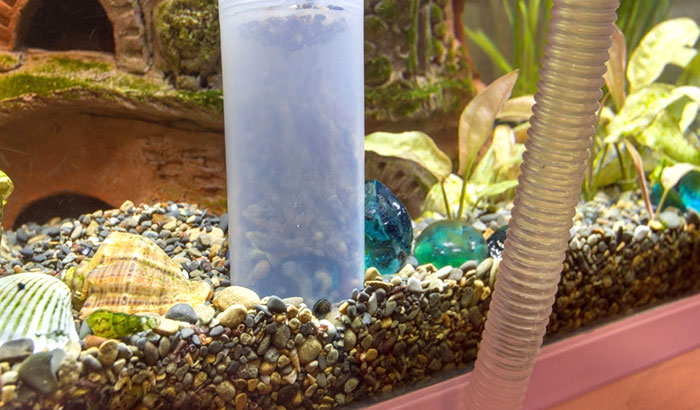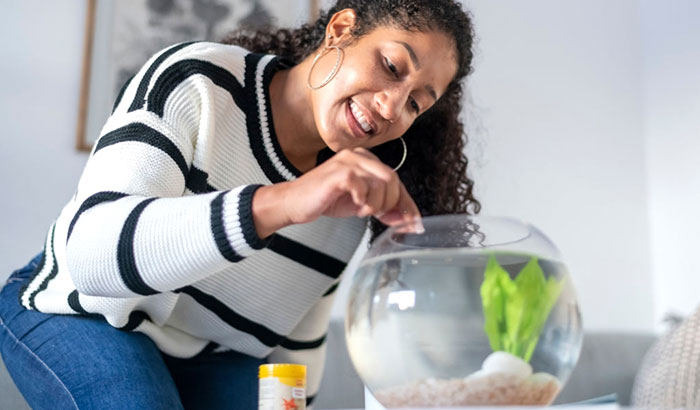Have you put too much food in the tank and the fish didn’t finish all the food? Overfeeding fish is a grave mistake to make if you care about the health and welfare of the fish. You need to learn how to remove uneaten food from the fish tank if you habitually put too much of it. This post will teach you how to keep your fish safe from dissolved flakes or pellets by taking either preventative or reparative action.
We will discuss why dissolved fish food is dangerous and ways to eliminate that danger.
Contents
Why Too Much Fish Food is Bad for the Fish
Obesity and Other Health Problems for the Fish
There are several reasons why you should be wary of putting too much fish food in the tank. The first one is you don’t want to overfeed your fish. Overfeeding the fish will result in bad health and eventually kill the fish. It can cause obesity, liver and kidney problems, and other detrimental effects on the internal organs of the fish.
Uneaten Fish Food Raises Ammonia and Nitrite Levels in the Tank
The second and perhaps more sobering reason you should not overfeed your fish is that it poisons their environment. A surplus of food in a fish tank will just end up dissolving and polluting the tank with ammonia and nitrite, both of which are toxic to fish. A tank with high ammonia and nitrite levels will stress and might even kill your fish.
If the tank has warm water – somewhere between 75 to 85 degrees Fahrenheit – there is the danger of ammonia and nitrite rising faster. The decomposition of the fish food requires dissolved oxygen in the water, and heat also decreases that oxygen. When the fish does not get enough oxygen, it is in danger of death.
Uneaten Fish Food Lowers pH Level
The breakdown or decomposition of any organic material releases carbon dioxide. In a body of water, that carbon dioxide becomes carbonic acid. Too much carbonic acid in the tank lowers the pH level of the water and can kill your fish if it requires an alkaline environment.
Uneaten Food Clogs Filters
Filtration devices are essential to keeping the water oxygenated. Fish food can clog up the filter in the tank and cause many problems. A clogged filter can’t function at total efficiency. It can’t oxygenate the water, the pH level, ammonia, and nitrite levels rise, and it will stress your fish to death.
Uneaten Food Contributes to Algae Growth
Lastly, dissolved uneaten food also raises the nitrate and phosphate levels in the tank. When these two compounds are abundant in water, they increase algae growth. And algae, in turn, is a sign of generally poor water quality. Poor water quality takes a toll on the immunity of the fish against diseases and makes their colors bleak.
How to Remove Uneaten Food from Fish Tank
There are several ways to remove uneaten food from a fish tank.
The Gravel Vacuum
Most of the time, uneaten fish food settles on the bottom of the tank, in the gravel. A gravel vacuum is a convenient tool to remove dissolved uneaten fish food that has settled on the bottom of the tank.
Simply place the vacuum’s head at the bottom of the tank and in the gravel. Then, direct its tube to a sink or a bucket. Turn on the vacuum and let it do all the work. It will siphon off the dissolved, uneaten food that settled at the bottom of the tank. It will also siphon a bit of water, which you should replace with clean, dechlorinated clean water.
Use an Aquarium Net
If the food has not yet fully dissolved and settled on the bottom of the tank, an aquarium net or sieve. This manual way of cleaning the tank is best if you have just recently fed your fish and realized that you gave too much food. The flakes, pellet, or whatever the food is should not have dissolved yet for this process to be effective.
Manually Clean the Tank
If you have no other options, cleaning the tank and its components by hand might be necessary. As an aquarist, you should know how to clean fish tanks since tank cleaning is essential every once in a while. But if you have terrible overfeeding habits, you have to clean the tank a lot more frequently than you would have to otherwise.
Remove the fish from the tank and place it in another container with clean, fish-worthy water. Then drain the water from the tank. Rinse and brush all the tank components to remove the grime, algae, and uneaten fish food. Put all the pieces back into the tank and fill it with fresh, dechlorinated, and fish-worthy water. Put your fish back, and you’re done manually cleaning the tank!
Prevent Getting Too Much Food in the Tank
- Here are a few tips to prevent getting too much uneaten food in the tank
- Put food in the tank according to the number of fish, not the size of the tank.
- Feed only what the fish can consume in two minutes. After two minutes, the remaining food will likely remain uneaten and dissolve.
- After two minutes, if the fish still seem hungry, feed it more but not too much.
- If you’ve put too much, remove the solid, uneaten food with a net or a siphon.
- Let your fish fast for one or two days each week.
- Have plenty of scavengers like catfish, snails, or shrimp to keep the bottom of the tank clean.
- Feed the correct type of food and the appropriate size for the fish.
- Use only fresh and high-quality food as the fish might reject it otherwise.
- Use an automatic feeder, if possible and especially when away.
- Choose a slightly oversized filter to keep the aquarium clean. Also, clean the filter regularly.
- Perform partial water change regularly while vacuuming the bottom of the tank.
Conclusion
Now you know how to remove unwanted food from a fish tank. Keep in mind, however, that prevention is better than finding a cure for a problem. Make sure you don’t get too much fish food in the tank in the first place, so you won’t have to deal with cleaning it.


